How To I SEE THE
Page 13
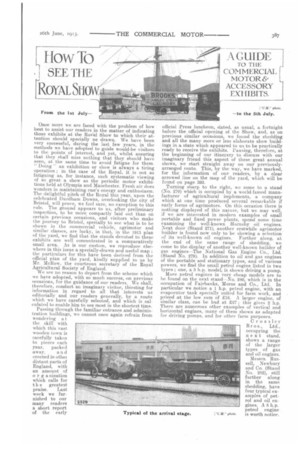
Page 14
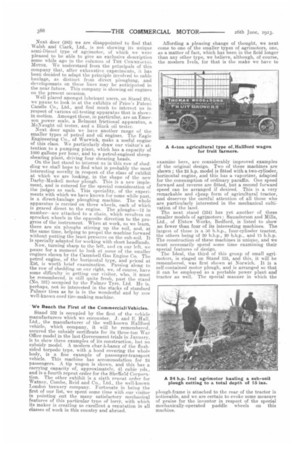
Page 15
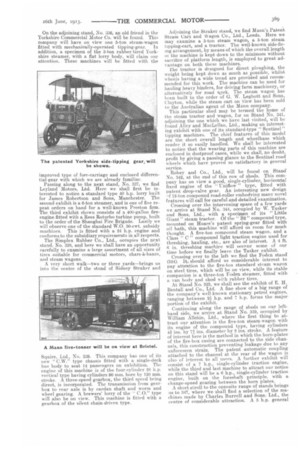
Page 16
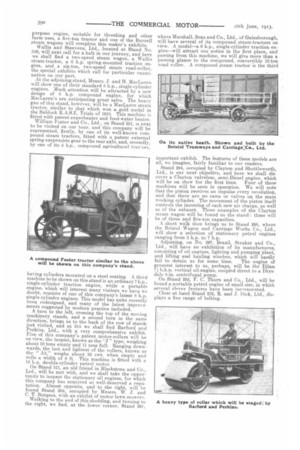
Page 17

Page 18
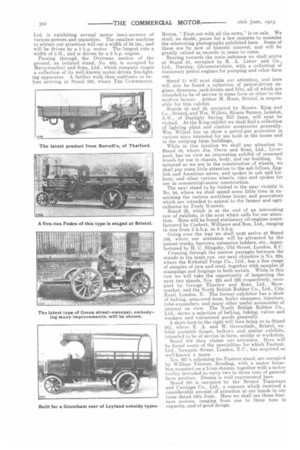
Page 19
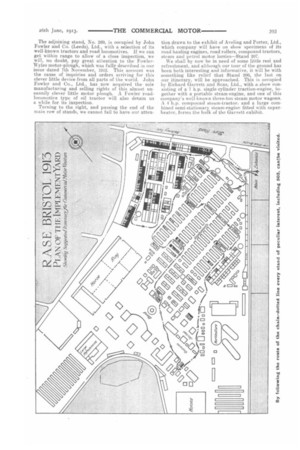
If you've noticed an error in this article please click here to report it so we can fix it.
[ROYAL Sii
A GUIDE
TO THE
COMMERCIAL [i MOTOR& ACCESSORY EXHIBITS. I
Once more we are faced with the problem of how best to assist our readers in the matter of indicating those exhibits at the Rolial Show to which their attention should specially be drawn. We have been very successful, during the last few years, in the methods we have adopted to guide would-be visitors to the points of interest, and yet, whilst assuring that they shall miss nothing that they should have seen, at the same time to avoid fatigue for them. " Doing" an exhibition or show is always a tiring operation ; in the case of the Royal, it is not so fatiguing as, for instance, such systematic viewing of so great a show as the periodic motor exhibitions held at Olympia and Manchester. Fresh air does wonders in maintaining one's energy and enthusiasm: The delightful pitch of the Royal this year, upon the celebrated Durdham Downs, overlooking the city of Bristol, will prove, we feel sure, no exception to this rule. The ground appears to us, after preliminary inspection, to be more compactly laid out than on certain previous occasions, and visitors who make the journey to Bristol, specially to see what is to be shown in the commercial vehicle, agrimotor and similar classes, are lucky, in that, in the 1913 plan of the yard, we find that the stands devoted to these exhibits are well concentrated in a comparatively small area. As is our custom, we reproduce elsewhere in this issue a specially-drawn and useful map ; the particulars for this have been derived from the official plan of the yard, kindly supplied to us by Mr. McRow, the courteous secretary of the Royal Agricultural Society of England. We see no reason to depart from the scheme which we have adopted, with so much success, on previous occasions, for the guidance of our readers. We shall, therefore, conduct an imaginary visitor, thirsting for information in regard to all that interests us editorially and our readers generally, by a route which we have carefully selected, and which is calculated to enable him to see most in the shortest time.
Passing through the familiar entrance and administration buildings, we cannot once again refrain from wondering at
the skill with which this vast wooden town is carefully taken to pieces each year, packed away, and erected in other distant parts of England, with an amount of organization which calls for the greatest praise. Last week we furnished to our many readers a short report of the early official Press luncheon, dated, as usual, a fortnight before the official opening of the Show, and, as on previous similar occasions, we found the shedding and all the many more or less elaborate show buildings in a. state which appeared to us to be practically ready to receive the exhibits. Pausing, therefore, at the beginning of our itinerary to discuss with our imaginary friend this aspect of these great annual shows, we start straight away on our previouslyarranged route. This, by the way, we have marked, for the information of our readers, by a clear arrowed line on the map of the yard, which will be found on page 393. Turning sharp to the right, we come to a stand (No. 270) which is occupied by a world-famed manufacturer of agricultural implements, a company which at one time produced several remarkable if early forms of agrimotors. On this occasion there is nothing displayed of this nature, but we may well, if we are interested in modern examples of small portable and fixed power plants, spend some time examining the well-known Hornsby oil engines. Next door (Stand 271), another erstwhile agrimotor builder is found now only to be showing a selection of its well-known oil engines. Further along, at the end of the same range of shedding, we come to the display of another well-known builder of gas engines—The National Gas Engine Co., Ltd. (Stand No. 279). In addition to oil and gas engines of the portable and stationary types, and of various powers, we find the small petrol engine listed in two types ; one, a 3 h.p. model, is shown driving a pump.
More petrol engines in very cheap models are to he found on the next stand—No. 280, which is in the occupation of Fairbanks, Morse and Co., Ltd. In particular we notice a 1 h.p. petrol engine, with an evaporator tank specially suited for farm work, and
priced at the low sum of £16. larger engine, of similar class, can be had at 127 this gives 2 h.p. There are numerous other examples of vertical and horizontal engines, -many of them shown as adapted for driving pumps, and for other farm purposes.
Crossley B r o s., Ltd., occupying the next stand. shows a range of the larger types of gas and oil engines.
Messrs. Russell, Newbury and Co. (Stand No. 282), still further alongin the same shedding, have four typical examples of petrol and oil engines. A 5 h.p. petrol engine is worth notice. Next door (283) we are disappointed to find that Walsh and Clark, Ltd., is not showing its unique semi-Diesel type of agrimotor, of which wewere pleased to be able to give an exclusive description some while ago in the columns of THE COMMEitC1A1. MOTOR. We understand from the principals of this company that, after exhaustive experiments, it has been decided to adapt the principle involved to cable haulage, as distinct from direct ploughing, and developments on these lines may be anticipated in the near future. This company is showing oil engines on the present occasion.
Well placed amongst lubricant users, on Stand 284, we pause to look in at the exhibits of Price's Patent Candle Co., Ltd., and find much to interest us in respect of various oil-testing apparatus that is shown in motion. Amongst these, in particular, are an Emerson _power scale, a Belmont frictional apparatus, a McNaught oil tester, and a. Black oil tester.
Next door again we have another range of the smaller types of petrol and oil engines. The Eagle Engineering Co., of Warwick, make a useful engine of this class. We particularly draw our visitor's attention to a pumping plant, which has a capacity of 1000 gallons per hour, and to a petrol-enginecl sheepshearing plant, driving four shearing heads.
On the last stand to interest us in this row of shedding we shall hope to find what is probably the most interesting novelty in respect of the class of exhibit at which we are looking, in the shape of the new Darby-Maskell motor plough. This is a new implement, and is entered for the special consideration of the judges as such. This speciality, of the experiments with which we have known for some while past, is a direct-haulage ploughing machine. The whole apparatus is carried on three wheels, each of which is geared direct to the engine. The ploughs-12 in number--are attached to a chain, which revolves on sprocket wheels in the opposite direction to the progress of the instrument. When at work, so we learn, there are six ploughs stirring up the soil, and, at the same time, helping to propel the machine forward without putting the least pressure on the sub-soil. It is specially adapted for working with short headlands.
Now, turning sharp to the left, and en our left, we pause for a moment to look at some of the smaller engines shown by the Campbell Gas Engine Co. The petrol engine, of the horizontal type, and priced at is worth brief examination. Passing along to the row of shedding on our right, we, of course, have some difficulty in getting our visitor, who, it must be remembered, is still quite fresh, past the stand (No. 231) occunied by the Palmer Tyre, Ltd. He is. perhaps, not so interested in the stacks of standard Palmer tires as he is in the wonderful and by now well-known cord tire-making machine.
' We Reach the First of the Comnsercialt Vehicles.
Stand 332 is occupied by the first of the vehicle manufacturers which we encounter. J. and E. Hall. Ltd., the manufacturer of the well-known Hallford vehicle, which company, it will be remembered. secured the subsidy certificate for its three-ton War Office model in the last Government trials in January, is to show three examples of its construction, but, no subsidy model. A modern char-à-bancs of the flushsided torpedo type, with a hood covering the whole body, is 11 fine example of passenger-transport vehicle. This machine has accommodation for 24 passengers. A tip wagon is shown, and this has a carrying capacity of, approximately, 4 cubic yds., and is a fourth repeat order for the Sheffield Corporation. The other exhibit is a sixth repeat order for Watney, Combe, Reid and Co., Ltd., the well-known
London brewery company. Fortunate in being the first of our list, we spent some time with our visitor in pointing out the many satisfactory mechanical features of this particular type of lorry, with which its maker is creating so excellent a reputation in all classes of work in this country and abroad. Affording a pleasing change of thought, we next come to one of the smaller types of agrimotors, one, as a matter of fact, which has been in the field longer than any other type, we believe, although, of course, the modern lye's, for that is the make we have to
examine here, are considerably improved examples of the original design. Two of these machines are shown; the 24 h.p. model is fitted with a two-cylinder,
O
horizontal engine, and this has a vaporizer, adapted for the consumption of ordinary paraffin. One speed forward and reverse are fitted, but a second forward speed can be arranged if desired. This is a very remarkable and cheap form of agricultural tractor, and deserves the careful attention of all those who are particularly interested in the mechanical cultivation of the land.
The next stand (334) has yet another of these smaller models of agrimotors : Saunderson and Mills, Ltd., of Elstow Works, Bedford, is listed to show no fewer than four of its interesting machines. The largest of these is a 50 b.h.p., four-cylinder tractor, the others being of 30 h.h.p., 20 b.h.p., and 15 b.h.p. The construction of these machines is unique, and we must necessarily spend some time examining their special features of design_
The Ideal, the third of this group of small agrimotors, is staged on Stand 335, and this, it will be remembered, was first shown at Norwich. It is a self-contained motor plough, and is arranged so that it can be employed as a portable power plant and tractor as well. The special manner in which the plough-frame is attached to the rear of the tractor is noticeable, and we are certain to evoke some measure of praise for the inventor in respect of the special mechanically-operated paddle wheels on this machine. On the adjoining stand, No. 336, an old friend in the Yorkshire Commercial Motor Co. will be found. This company will have on view one 5-ton steam-wagon fitted with mechanically-operated tipping-gear. In addition, a specimen of the 3-ton rubber-tired Yorkshire steamer, with a flat lorry body, will claim our attention. These machines will be fitted with the improved type of fore-carriage and enclosed differential-gear with which we are already familiar. Passing along to the next stand, No. 337, we find Leyland Motors, Ltd. Here we shall first be interested to notice a standard type 40 h.p. lorry built for James Robertson and Sons, Manchester. The second exhibit is a 6-ton steamer, and is one of five repeat orders on hand for a well-known Preston firm. The third exhibit shown consists of a 400-gallon fireengine fitted with a, Rees Roturbo turbine pump, built to the order of the Shanghai Fire Brigade. Lastly we will observe one of the standard W.O. 30-cwt. subsidy machines. This is fitted with a 24 h.p. engine and conforms to the subsidiary requirements in all respects. The Simplex Rubber Co., Ltd., occupies the next stand. No. 338, and here we shall have an opportunity carefully to examine a large assortment of all sizes of tires suitable for commercial motors, chars-ii-bancs, and steam wagons.
A very short walk—two or three yards—brings us into the centre of the stand of Sidney Straker and
Squire, Ltd., No. 339. This company has one of its new " C.W." type chassis fitted with a single-deck bus body to seat 14 passengers on exhibition. The engine of this machine is of the four-cylinder 28 h.p. vertical type having cylinders 90 min. bore by 120 ram stroke. A three-speed gearbox, the third speed being direct, is incorporated. The transmission from gearbox to rear axle is by cardan shaft and worm and wheel gearing. A brewers' lorry of the " C.O." type will also be on view. This machine is fitted with a gearbox of the silent chain-driven type. Adjoining the Straker stand, we find Mann's Patent Steam Cart and wagon Co., Ltd., Leeds. Here we may examine a 5-ton steam wagon, a 5-ton steam tipping-cart, and a tractor. The well-known side-firing arrangement, by means of which the overall length ox the machine is kept down to the minimum without sacrifice of platform length, is employed to great advantage on both these machines.
The tractor is designed for direct ploughing, the weight being kept down as much as possible, whilst wheels having a wide tread are provided and recommended for this work. The machine can be used for hauling heavy binders, for driving farm machinery, or alternatively for road wprk. The steam wagon has been built to the order of G. W. Leghott and Sons, ('Layton, while the steam cart on view has been sold to the Australian agent of the Mann company.
This particular shed may be termed the home of the steam tractor and wagon, for on Stand No. 341, adjoining the one which we have last visited, will be found Alley and MacLellan, Ltd., making an interesting exhibit with one of its standard-type "Sentinel" tipping machines. The chief features of this model are the short overall length and wheelbase which render it so easily handled. We shall be interested to notice that the wearing parts of this machine are enclosed in dustproof cases, while we shall, no doubt, profit by giving a passing glance to the Sentinel road wheels which have proved so satisfactory in general service.
Robey and Co., Ltd., will be found on Stand' No. 342, at the end of this row of sheds. This company has on view a good, single-cylinder, horizontal fixed engine of the " rnifiow " type, fitted with patent drop-valve gear. An interesting new design "If 12-ten compound road-roller embodying many novel features will call for careful and detailed examination.
Crossing over the intervening space of a. few yards we arrive at Stand No. 344, occupied by W. Tasker and Sons, Ltd., with a specimen of its "Little Giant" steam tractor. Of the "B2" compound type, mounted on Hoare's patent spring-gear fitted with oil bath, this machine will afford us room for much thought. A five-ton compound steam wagon, and a Class " C " compound light traction engine used for threshing, hauling, etc., are also of interest. A 4 ft. 6 in. threshing machine will occnny some of our time before we finally leave the Tasker exhibit.
Crossing over to the left we find the Foden stand (324). It,. should afford us considerable interest to pay attention to the five-ton standard steam wagon on steel tires, which will be on view, while its stable companion is a, three-ton Poden steamer, fitted with a van body and shod with rubber tires.
At Stand No. 323, we shall see the exhibit of E. H. Bentall and Co., Ltd. A fine show of a big range of the company's well-known stationary petrol engines, ranging between 2.i h.p. and 7 bp. forms the majorportion of the exhibit. Continuing along the range of sheds on our lefthand side, we arrive at Stand No. 319, occupied by William Allchin, Ltd., where the first thing to attract our attention is the five-ton steam-wagon with its engine of the compound type, having cylinders a ins. by I ins, diameter by 8 ins. stroke. A feature of interest here is the method in which the horn-plates of the fire-box casing are connected to the side channels, this construction preventing leakage due to any unforeseen strain. The patent automatic coupling attached to the channel at the rear of the wagon is also of interest to all users. A further exhibit will consist of a 7 h.p„ single-cylinder traction engine, while the third and last machine to attract our notice on this stand will be a 6 h.p., single-cylinder traction engine, built on the foreshaft principle, with a, change-speed gearing between the horn plates. A short stroll to the opposite range of stands brings us to 347, where we shall find a selection of the machines made by Charles Burrell and Sons, Ltd., the centre of considerable attraction. A 5 h.p. general
purpose engine, suitable for threshing and other farm uses, a five-ton tractor and one of the Burrell steam wagons will complete this maker's exhibits. Wallis and Steevens, Ltd., located at Stand No. 349, will next call for a halt in our journey, and here we shall find a two-speed steam wagon, a Wallis steam-tractor, a 6 h.p. spring-mounted traction engine, and a six-ton, two-speed steam road-roller. the special exhibits which call for particular examination on our part. At the adjoining stand, Messrs. J. and H. MacLaren will show one of their standard 8 h.p., single-cylinder engines. Much attention will be attracted by a new design of 8 h.p. compound engine, for which MacLaren's are anticipating great sales. The heavy gun of this stand, however, will be a MacLaren steam tractor, similar to that which won a gold medal in the Baldock R..A.S.E. Trials of 1910. This machine is fitted with patent superheater and feed-water heater. William Foster and Co., Ltd., on Stand 351, is next to be visited on our tour, and this company will be represented, firstly, by one of its well-known compound steam tractors, fitted with a patent external spring-suspension gear to the rear axle, and, secondly, by one of its 6 h.p., compound agricultural tractors,
having cylinders mounted on a steel seating. A third machine to be shown on this stand is an ordinary 7 h.p., single-cylinder traction engine, while a portable engine, which will interest many visitors we have no doubt, consists of one of this company's latest 8 h.p. single-cylinder engines. This model has quite recently been redesigned, and many of the latest improvements suggested by modern practice included.
A turn to the left, crossing the top of the moving machinery stands, and a second turn in the same direction, brings us to the back of the row of stands just visited, and at 314 we shall find Barford and Perkins, Ltd., with a very comprehensive exhibit. Five of this company's patent motor-rollers will be on view, the largest, known as the "J" type, weighing about 10 tons empty and 11 tons full. Ranging downwards, the last and lightest of the rollers, known as the " A3," weighs about 33 cwt. when empty and rolls a width of 6 ft. This machine is fitted with a 12 h.p. double-cylinder petrol motor.
On Stand 311, an old friend in Blackstone and Co., Ltd., will be met with, and we shall take the opportunity to inspect the stationary oil engines, for which this company has acquired so well-deserved a reputation. Almost opposite, and to the right, will be found Stand 304, occupied by Messrs. W. J. and C. T. Burgess, with an exhibit of motor lawn mowers. Walking to the end of this shedding, and turning to the right, we find, at the lower corner, Stand 291, where Marshall, Sons and Co., Ltd., of Gainsborough, will have several of its compound steam-tractors on view. A model—a 6 h.p., single-cylinder traction engine—will attract our notice in the first place, and passing from this machine, we will give more than a passing glance to the compound, convertible 10-ton road roller. A compound steam tractor is the third important exhibit. The features of these models are all, we imagine, fairly familiar to our readers. Stand 294, occupied by Clayton and Shuttleworth, Ltd., is our next objective, and here we shall discover a Clayton valveless, semi-Diesel engine, which will be on show for the first time. Four of these machines will be seen in operation. We will note that the piston receives an impulse every revolution, and that there are no cams or valves on the main working cylinder. The movement of the piston itself controls the incoming of each new air charge, as well as of the exhaust. Three examples of the Clayton steam wagon will be found on the stand : these will be of three and five-ton capacities. A short walk then brings us to Stand 298, where the Bristol Wagon and Carriage Works Co., Ltd., will show a 'selection of stationary petrol engines ranging from 3 h.p. to 7 h.p. Adjoining, on No. 297, Brazil, Straker and Co., Ltd., will have an' exhibition of its manufactures, consisting of oil engines, lighting and pumping plant, and lifting and hauling winches, which will hardly fail to detain us for some time. The engine of greatest interest to us, perhaps, will be the Djinn b.h.p. vertical oil-engine, coupled direct to a Drysdale 8-in, centrifugal pump.
On Stand 252, F. C. Thorn and Co., Ltd., will be found a. portable petrol engine of small size, in which several clever features have been inc-,rporated.
Close at hand Stand 232, R. and J. Dick, Ltd., displays a fine range of belting. Crossing over to the left we find ourselves at Stand 237, occupied by W. H. Willcox and Co., Ltd., with a comprehensive display of its well-known pumps, injectors, armoured hose, belting, and many other accessories for use on steam wagons, agrimotors, and tractors. It is, of course, impossible within the limits of a small stand to display every useful accessory factored by W. H. Willcox and Co., Ltd. We shall experience no difficulty in obtaining full particulars, information and advice from the Wilcox representative in charge, however, including particulars of "prize " lubricants.
We next pass along to Stand 242, where also will be found a display of lubricants, and suction and delivery hose for use with steam and petrol tractors and general motor-driven farming machinery. We shall manifest some little interest also, we imagine, in the. asbestos and hydraulic packings for general steam use, which are priced at between Is. and 2s. per lb. William Eddington and Co.. Plaistow, London, .E., are responsible for this exhibit.
Turning sharply to the left a few stands higher up, we shall have presented to our view the well-known exhibit, which is by now practically standardized, of The British Petroleum Co., Ltd. Samples of this company's oils and greases will be on view, together with the oil-storage tanks and other packages.
Adjoining will be found the exhibit of the AngloAmerican Oil Co., Ltd., Bristol, where samples of Pratt's "Perfection," and "Taxibus" spirit will be on view. Here also will be seen cans used in the transportation of the Anglo-American special spirit for lighting purposes. Oils for use in internal-combustion engines generally, together with wood and steel barrels for the transportation of petrol and lubricating oils, complete the exhibit.
Making a further sharp turn to the left we will find several stands of particular interest to us within the space of a few sq. yards. Stand 176 is devoted to the productions of the Electric and Ordnance Accessories Co., Ltd., which will be showing the famous " Timkin " roller bearings, which are in general use in the production of many of the leading commercial motor manufacturers. Although agricultural engines and machinery generally are designed in the first place with a view to low cost of production, users are realizing that a little extra expense in the provision of roller-bearings is more than repaid in the lower working costs of the machines.
Under the same shedding we shall see an exhibit staged by the Bristol Waggon and Carriage Works Co., Ltd., consisting of a representative exhibit of general interest to the agriculturist—Stand 179. Crossing over to the right, the well-known name of J. W. and T. Connolly, Ltd., will greet our eye, and, pausing for a while, we will be able carefully to examine the solid tires and other productions of this manufacturer —Stand 175.
On the adjoining stand (171) there will be found several car chassis shown by Welsh and Co., Ltd., Redcliffe Backs, Bristol. These are shown as suitably low-priced cars for the use of the modern farmer who finds efficient transport methods as valuable to him as does the busy city man.
Close by we shall see specimens, on Stand 173, of the products of the Coventry Chain Co., Ltd. Noiseless chains for the transmission of power on agricultural machiriery, in addition to roller and block chains, which are used for many other purposes than on chassis, will also be on view, together with a selection of hoisting chains designed for heavy lifting purposes. Two Studebaker cars we shall find exhibited by S. and A. Fuller, Kingsmead Street, Bath. on Stand 174. Having cast an eye over these machines we will next spend some little time on Stand 168. where an old friend, Scout Motors, Ltd., is located. This company will have on exhibition two of its, by now well-known lorries, a two-tonner and three-tonner, respectively. The exhibit will be rounded off by two Scout chassis, designed for pleasure purposes, which are intended to appeal to the farmer both for business and pleasure. A walk along quite a number of stands then confronts us before we reach the next exhibit of peculiar interest to us. Turning to the left at the end of the long main row of stands, we shall arrive at No. 456, which is occupied by the G.W.R. Co., Ltd.. with a collection of sample boxes used for the transport and delivery of farm materials. Just behind the Railway Co.'s exhibit we shall find Stand No. 455, where Ransomes, Sims and Jefferies, Ltd. is exhibiting several motor lawn-mowers of various powers and capacities. The smallest machine to attract our attention will cut a width of 24 ins., and will be driven by a 3 h.p. motor. The largest cuts a width of 3 ft., and is driven by a 6 h.p. engine. Passing through the Overseas section of the ground, an isolated stand, No. 485, is occupied by Merryweather and Sons, Ltd., which company stages a collection of its well-known motor-driven fire-fighting apparatus. A further walk then confronts us before arriving at Stand 503, where THE COMMERCIAL MOTOR, "First out with all the news," is on sale. We shall, no doubt, pause for a few minutes to examine the interesting photographs exhibited here. Some of these are lay now of historic interest, and will be greatly valued as records in years to come.
Bearing towards the main entrance we shall arrive at Stand 56, occupied by R. A. Lister and Co., Ltd., Dursley, Gloucestershire, with a collection of stationary petrol engines for pumping and other farm use.
Stand 51 will next claim our attention, and here will also be found a collection of petrol-driven engines, dynamos, sack-hoists and lifts, all of which are intendechto be of service in some form or other to the modern farmer. Arthur M. Hunt, Bristol, is responsible for this exhibit.
Stands 43 and 42, occupied by Messrs. King and Co., Bristol, and Wm. Willett, Sloane Square, London, S. W., of Daylight Saving Bill fame, will next be visited. At the King exhibit we shall find a collection of lighting plant and electric accessories generally. Wm. Willett has on show a petrol-gas generator in various sizes intended for use both in the house and in the outlying farm buildings. While in this location we shall pay attention to Stand 85, where Jos. Owen and Sons, Ltd., Liverpool, has on view an interesting exhibit of seasoned woods for use in chassis, body, and car building. Interested as we are in the construction of wheels, we shall pay some little attention to the ash felines, English and American naves, and spokes in oak and hickory, and other various wheels, rims and spokes for use in commercial-motor construction.
The next stand to be visited in the near vicinity is No. 94, where we shall spend some little time in examining the various acetylene lamps and generators which are intended to appeal to the farmer and agriculturist by Penly Werrett.
Stand 39, which is at the end of an interesting row of exhibits, is the next which calls for our attention. Here will be found stationary oil-engines manufactured by Corbett, Williams and Son, Ltd., ranging in size from 3 b.h.p. to 9 b.h.p.
Going over the way we shall next arrive at Stand 109, where our attention will be attracted by the patent trucks, barrows, extension ladders, etc., manufactured by H. C. Slingshy, Old Street, London, E.C.
Crossing through the narrow passages between the stands in the main row, our next objective is No. 224, where the Kirkstall Forge Co., Ltd., has a fine range of samples of iron and steel, together with samples of stampings and forgings in both metals. While in this row we will take the opportunity of inspecting the next two stands, Nos. 225 and 226 respectively, occupied by George Thurlow and Sons, Ltd., Stowmarket, and the North British Rubber Co., Ltd., City Road, London, N. The former exhibitor has a show of belting, armoured hose, boiler cleansers, injectors, tube-expanders, and many other useful accessories of interest on view. The North British Rubber Co., Ltd., shows a selection of belting, tubing, valves and washers and vulcanized goods generally.
A short turn to the right will then bring us to Stand 261, where E. A. and W. Greenslade, Bristol, exhibit portable forges, bellows, and similar exhibits, intended to be of service in farm, smithy or workshop.
Stand 29 then claims our attention. Here will be found many of the specialities for which Fastnut, Ltd., Newgate Street, London, KC., has acquired so well-known a name.
Nos. 267-8, adjoining the Fastnut stand, are occupied by William Vincent, Reading, with a motor horsebox mounted on a 3-ton chassis, together with a motor trolley intended to carry two to three tons of general farm produce. Dennis is well represented here.
Stand 2633 is occupied by the Bristol Tramways and Carriage Co., Ltd., a concern which received a considerable amount of attention at our hands in our issue dated 19th June. Here we shall see three business motors. ranging from one to three tons in capacity, and of good design.
The adjoining stand, No. 269, is occupied by John Fowler and Co. (Leeds), Ltd., with a selection of its well-known tractors and road locomotives. If we can get within range to allow of a close inspection, we will, no doubt, pay great attention to the FowlerWyles motor-plough, which was fully described in our issue dated 7th November, 1912. This account was the cause of inquiries and orders arriving for this clever little device from all parts of the world. John Fowler and Co., Ltd., has now acquired the sole manufacturing and selling rights of this almost uncannily clever little motor plough. A Fowler roadlocomotive type of oil tractor will also detain us a while for its inspection.
Turning to the right, and passing the end of the main row of stands, we cannot fail to have our atten
tion drawn to the exhibit of Aveling and Porter, Ltd., which company will have on show specimens of its road hauling engines, road rollers,. compound tractors, steam and petrol motor lorries—Stand 297. We shall by now be in need of some little rest and refreshment, and although our tour of the ground has been both interesting and informative, it will be with something like relief that Stand 206, the last on our itinerary, will be approached. This is occupied by Richard Garrett and Sons, Ltd., with a 'show consisting of a 7 h.p. single-cylinder traction-engine, together with a portable steam-engine, and one of this company's well-known three-ton steam motor wagons. A I h.p. compound steam-tractor, and a large combined semi-stationary steam-engine fitted with superheater, forms the bulk of the Garrett exhibit.
































